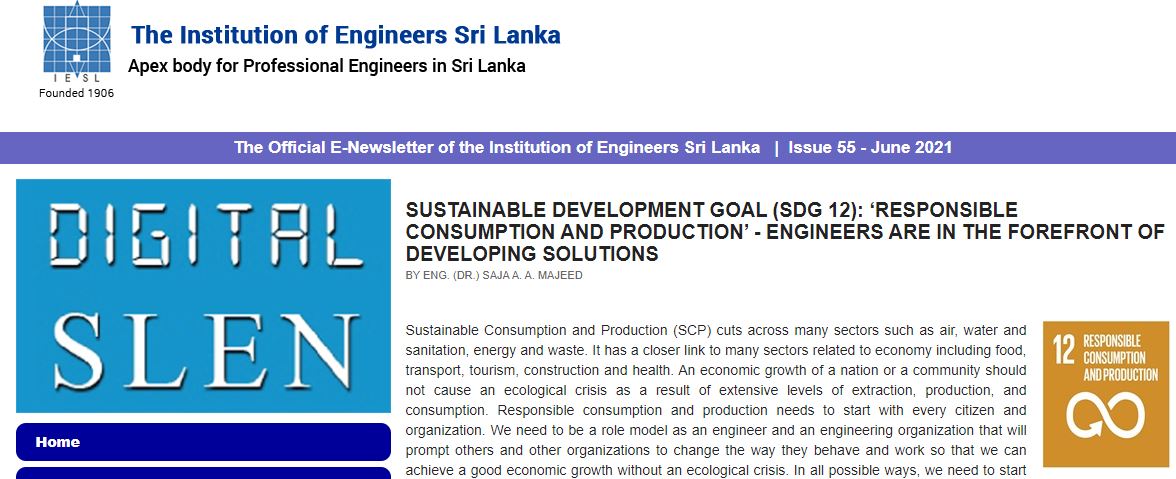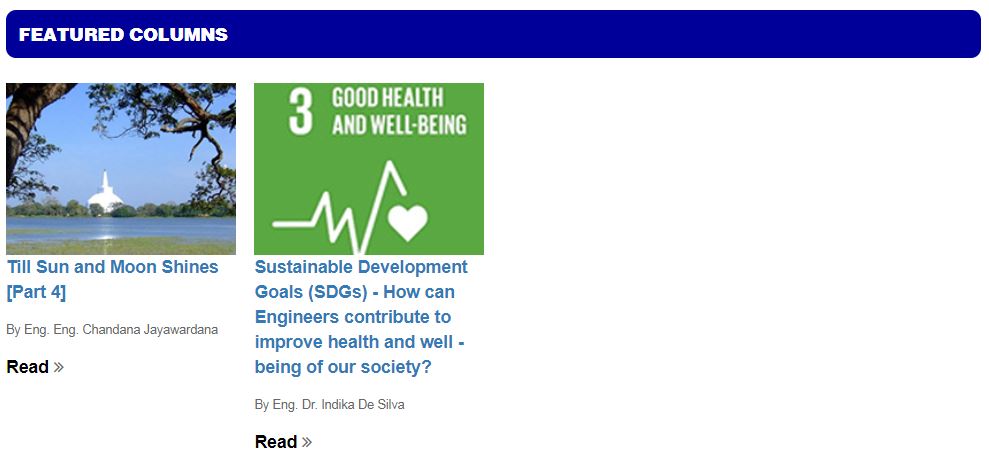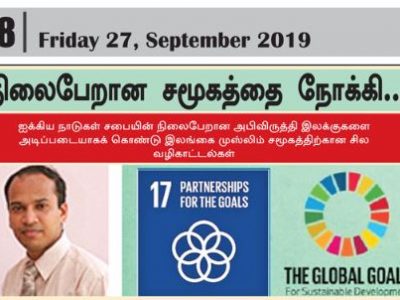Development Challenges in the East, published in Sunday Observer
A timely write up by Dr. AMA. Saja and Dr. SM. Junaideen providing an overview of six key challenges to the development programs in the Eastern Province of Sri Lanka was featured in Sunday Observer on 18 October 2020.
http://www.sundayobserver.lk/2020/10/18/news-features/development-challenges-east

By Eng. (Dr.) A.M.A. Saja and Eng. (Dr.) S.M. Junaideen
The aim of this article is to present the key challenges to sustainable development in the Eastern region of Sri Lanka, with a view to initiating a wider multi-stakeholder dialogue to find innovative solutions within an integrated sustainable development framework. In this context, rather than elaborating a detailed account or research findings for each of the development priorities, it also provides a basis for further discussion among the policy makers and concerned stakeholders to enable well-informed and participatory decision making at all levels.
The Eastern Province
In the National Physical Planning Policy and Plan Sri Lanka-2030, prepared by the National Physical Planning Department, the Eastern Province is identified as one of the five Metropolitan Regions in the country. It is envisioned that the Eastern Province will be a vibrant ‘Sun Rise Region’ by 2030 with a sound regional economy, enhanced income levels and a socially, harmonious human settlement structure whilst maintaining the uniqueness of the Province.
The Eastern Province comprises three administrative districts; Ampara, Batticaloa and Trincomalee, and covers an area about 10,000 km2. It has a great share of the great wealth of the country’s natural resources, approximately 25 per cent of the coast, 25 per cent of the lagoons, 28 per cent of mangroves, and 31 per cent fresh marshes. The population of the Province was about 1.54 million as per the statistics from 2012, which is about 8 per cent of the total population of Sri Lanka.
The National Physical Plan 2030 shows the potential metro regions in the country connecting high population cities (Figure 1). The Eastern Metro region, along the stretch of the coastal towns from Vaalaichenai towards Oluvil, in the districts of Batticaloa and Ampara and including the inland cities such as Sammanthurai and Ampara towns, is expected to have a one million population by 2030 (Kurukulasuriya 2012). This region includes key municipalities and emerging towns .
The economic significance of the Eastern Metro region is agriculture, fisheries, tourism, livestock development, energy production, small and medium enterprises and other manufacturing potentials and therefore is making this region a key contributor in national and regional development of the country. Yet, due to rapid urbanisation of these areas, many key challenges have been emerging, which need urgent attention. with extensive research to strategise feasible and effective solutions.
Emerging challenges to the development in the Eastern Region
The uniqueness of the Eastern region in terms of its landscape and bio-diversity has brought a unique combination of development challenges interfacing urban and rural areas: typically, Solid Waste Management (SWM), Wastewater Management (WWM), Traffic Congestions and Accidents (TCA), Coastal Erosion (CE), and Human-Elephant Conflict (HEC). The urban areas in the Eastern region lack WWM systems, and there seems to be no strategic planning as yet to tackle this problem.
TCA is on the increase in the urban centres of the region. CE has been a challenge for the coastal communities, who depend on coastal resources for their livelihood and habitation. HEC has been a threat to the agricultural production and habitation of peri-urban and rural communities.
Each of these problems needs to be addressed strategically within an integrated sustainable development framework. The challenges need to be further studied to come up with scientific solutions.
A) Solid Waste Management (SWM)
Waste collection and disposal are increasingly causing negative environmental issues, and there is an urgent need to find alternative solutions. The draft national action plan on solid waste management highlighted the needs for a public monitoring system, electronic data collection and forecasting of waste generation data, as well as use of big data, internet of things and a dashboard to facilitate the complete process of solid waste management.
The generation of Municipal Solid Waste (MSW) in Sri Lanka is 7210 tons/day, however, the collection efficiency is only around 27 per cent (Basnayake et al. 2018). The Eastern region is no exception, for example, the Kalmunai Municipal Council is in a crisis situation today with a huge quantity of MSW (35 – 40 tons per day) having to be managed on a daily basis.
B) Wastewater Management (WWM)
Wastewater management continues to be a challenge in the Eastern province. There has been no centralised wastewater treatment system nor proper wastewater disposal systems in many congested cities in the eastern region leading to onsite wastewater disposal harming the environment and resulting in significant public health issues.
The municipalities and urban areas in the East coast should be prioritised for constructing suitable wastewater disposal system(s) as they fall under the top 15 most congested cities in Sri Lanka . The wastewater disposal systems have already been planned and are in the pipeline for the Batticaloa Municipality and Kattankuddy urban council areas.
C) Traffic Congestions and Accidents (TCA)
The Eastern coastline has increasingly become congested within many urban centres since the end of the battle against terrorism in 2009. There has also been a corresponding increase in the number of vehicles on roads. With the limited expansion potential of road infrastructure along the coastline, traffic accidents have become a major cause of death.
According to the 2019 vehicle registry in the Motor Traffic Department, more than 400,000 vehicles have been registered in the Eastern Province. The ever increasing vehicle population has serious consequences in public vehicle parking spaces causing huge traffic congestions and accidents.
Alternative mass transport systems, such as the opportunity to expand the railway line from Batticaloa towards Pottuvil should be explored. The National Physical Planning Policy and the Plan 2050 included an extension of eastern coastal railway connecting to the southern region.
D) Coastal Erosion (CE)
The coastal areas around the Oluvil harbour are facing severe erosion, affecting the livelihood of fishermen in the region. The sediment transport in the near shore has resulted in deposition of sand in the harbour entrance and severe erosion on the north side of the harbour.
Hundreds of acres of land have been lost and thousands of coconut trees have been uprooted north of the harbour by coastal erosion.
Without proper parking places and storage arrangements, fishing boats and accessories had been damaged in the past paralysing the fishing industry in the area.
Although some short-term remedial measures were implemented by the authorities, long term risk assessment and necessary preventive measures need to be taken by the authorities regarding coastal erosion.
E) Human-Elephant Conflict (HEC)
The damage to agricultural crops has become the most common consequence of the human-elephant conflict and reported more frequently than the attacks on human and physical infrastructure. There is a need for immediate solutions to mitigate the impact of human-elephant conflict, which demands advance technological solutions that can track the movement of elephants into the human settlements and report the intrusion of elephants to the respective authorities for immediate actions.
The intrusion of elephants in the agriculture fields and human settlements are seasonal.
Many different types of mitigation measures have been proposed and implemented such as electric or bio-fences, establishing elephant corridors and enriching the elephant’s habitat.
Further research studies are needed to explore the use of advanced technologies to assist people at risk and the authorities, enabling an effective emergency communication and management system to mitigate the damage due to human-elephant conflict.
Sustainable Development Goals with the emerging themes
These thematic focus areas for addressing the key developmental challenges are in line with the policies of Vistas of Prosperity and Splendour of President of Gotabaya Rajapaksa, for a prosperous Sri Lanka. Moreover, they have closer relevance to the United Nations Sustainable Development Goals (SDGs).
In general, SDGs such as Clean water and sanitation (SDG 6), Affordable clean energy (SDG 7), Industry/Innovation/Infrastructure (SDG 9), Sustainable cities and communities (SDG 11), and Responsible consumption and production (SDG 12) have direct linkages to research and development in Engineering and Technology.
Hence, urgent attention needs to be given to initiate a multi-stakeholder regional level consultation and research with thematic experts with the Engineering and Development Experts in the region, since engineering research and portfolios have a greater role to play in addressing the above highlighted emerging challenges.
[Some of the contents in this article are from the panel discussion on “Achievement of Sustainable Development Goals and contribution of Engineers”, organised at the event held on March 4, 2020 to mark the World Engineering Day 2020 for Sustainable Development at the Faculty of Engineering, South Eastern University of Sri Lanka].
The writers are members of the Faculty of Engineering, South Eastern University of Sri Lanka, Oluvil







